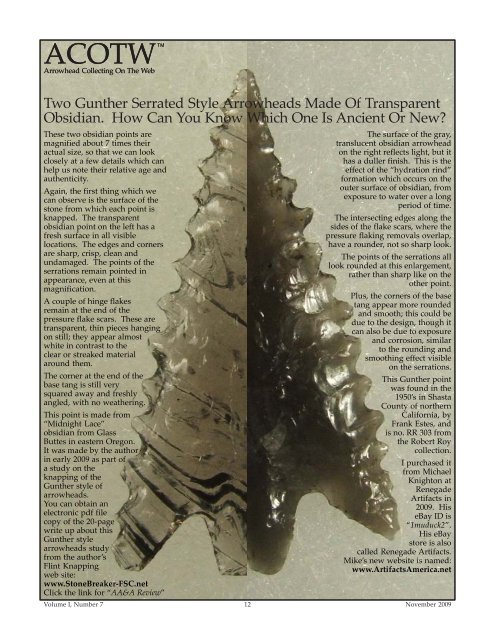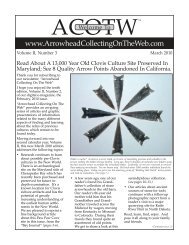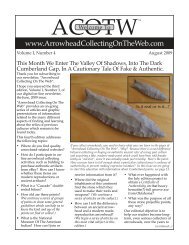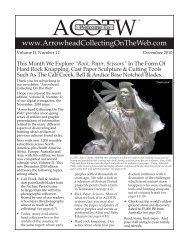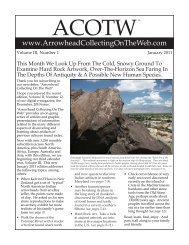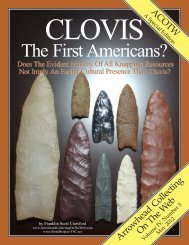STOP! - Arrowhead Collecting On The Web
STOP! - Arrowhead Collecting On The Web
STOP! - Arrowhead Collecting On The Web
You also want an ePaper? Increase the reach of your titles
YUMPU automatically turns print PDFs into web optimized ePapers that Google loves.
ACOTW<br />
<strong>Arrowhead</strong> <strong>Collecting</strong> <strong>On</strong> <strong>The</strong> <strong>Web</strong><br />
<strong>Arrowhead</strong> <strong>Collecting</strong> <strong>On</strong> <strong>The</strong> <strong>Web</strong><br />
TM<br />
Two Gunther Serrated Style <strong>Arrowhead</strong>s Made Of Transparent<br />
Obsidian. How Can You Know Which <strong>On</strong>e Is Ancient Or New?<br />
<strong>The</strong>se two obsidian points are<br />
magnified about 7 times their<br />
actual size, so that we can look<br />
closely at a few details which can<br />
help us note their relative age and<br />
authenticity.<br />
Again, the first thing which we<br />
can observe is the surface of the<br />
stone from which each point is<br />
knapped. <strong>The</strong> transparent<br />
obsidian point on the left has a<br />
fresh surface in all visible<br />
locations. <strong>The</strong> edges and corners<br />
are sharp, crisp, clean and<br />
undamaged. <strong>The</strong> points of the<br />
serrations remain pointed in<br />
appearance, even at this<br />
magnification.<br />
A couple of hinge flakes<br />
remain at the end of the<br />
pressure flake scars. <strong>The</strong>se are<br />
transparent, thin pieces hanging<br />
on still; they appear almost<br />
white in contrast to the<br />
clear or streaked material<br />
around them.<br />
<strong>The</strong> corner at the end of the<br />
base tang is still very<br />
squared away and freshly<br />
angled, with no weathering.<br />
This point is made from<br />
“Midnight Lace”<br />
obsidian from Glass<br />
Buttes in eastern Oregon.<br />
It was made by the author<br />
in early 2009 as part of<br />
a study on the<br />
knapping of the<br />
Gunther style of<br />
arrowheads.<br />
You can obtain an<br />
electronic pdf file<br />
copy of the 20-page<br />
write up about this<br />
Gunther style<br />
arrowheads study<br />
from the author’s<br />
Flint Knapping<br />
web site:<br />
www.StoneBreaker-FSC.net<br />
Click the link for “AA&A Review”<br />
<strong>The</strong> surface of the gray,<br />
translucent obsidian arrowhead<br />
on the right reflects light, but it<br />
has a duller finish. This is the<br />
effect of the “hydration rind”<br />
formation which occurs on the<br />
outer surface of obsidian, from<br />
exposure to water over a long<br />
period of time.<br />
<strong>The</strong> intersecting edges along the<br />
sides of the flake scars, where the<br />
pressure flaking removals overlap,<br />
have a rounder, not so sharp look.<br />
<strong>The</strong> points of the serrations all<br />
look rounded at this enlargement,<br />
rather than sharp like on the<br />
other point.<br />
Plus, the corners of the base<br />
tang appear more rounded<br />
and smooth; this could be<br />
due to the design, though it<br />
can also be due to exposure<br />
and corrosion, similar<br />
to the rounding and<br />
smoothing effect visible<br />
on the serrations.<br />
This Gunther point<br />
was found in the<br />
1950’s in Shasta<br />
County of northern<br />
California, by<br />
Frank Estes, and<br />
is no. RR 303 from<br />
the Robert Roy<br />
collection.<br />
I purchased it<br />
from Michael<br />
Knighton at<br />
Renegade<br />
Artifacts in<br />
2009. His<br />
eBay ID is<br />
“1muduck2”.<br />
His eBay<br />
store is also<br />
called Renegade Artifacts.<br />
Mike’s new website is named:<br />
www.ArtifactsAmerica.net<br />
Volume I, Number 7 12<br />
November 2009


